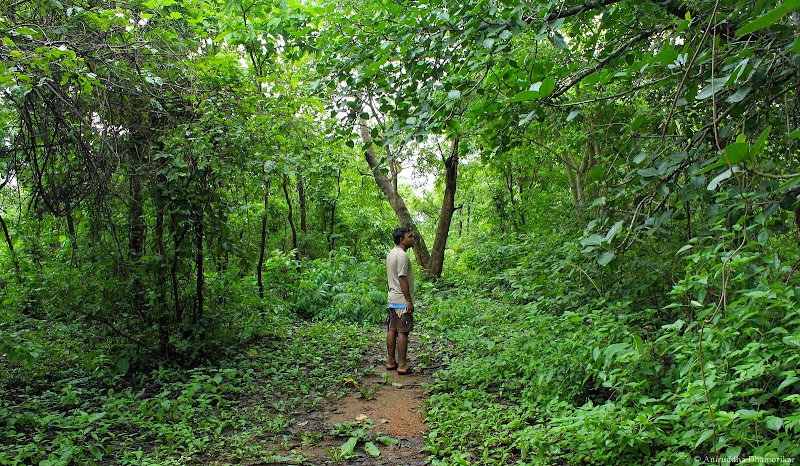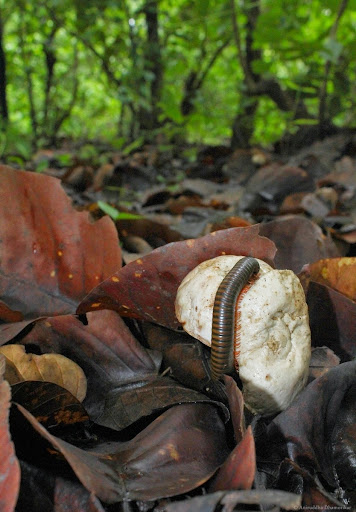Barefoot Notes: Bhoolandara
Bhoolandara is not
what you think it is. If you know Hindi, you might guess that it has something
to do with bhoolna (meaning, to
forget, or to go astray). If you think it means doorway-to-forget-things,
you’re pretty close, but not exactly.
There is a phenomena called going-in-circles when lost in a
forest, I don’t think it has any specific English name (in Maharashtra it is
called chakwa, in Madhya Pradesh Bhoolandara), but research
has concluded that we intend to walk in a circle if we’re lost without the
sense of direction; why or how, we’re still figuring that out.
I’ve never been lost in a forest in true sense, once a
friend and I took an off-beaten track with the intentions of exploring
something unexplored, but we ended up in a village where we had began. On this
occasion, though, we were truly lost – and I might say hopelessly.
Dayal (the one who taught us the Mahua
vegetable recipe!) and I went off into the forests to explore the monsoon
flora and fauna one fine Saturday morning. And we didn’t return on the time we
intended to.
 |
| Dayal contemplating one of the many dead-end paths. |
We counted countless mushrooms, fresh under a humid Sal
forest, and we saw scorpions black as night. Spiders here hung low from their
webs, with some content with the meal they had secured. If you’ll allow me, I’d
have called it Mirkwood, and the spiders the breed of Ungoliant, and the maze a
curse laid long ago upon this fell lands. But it was none of this – contrary to
what I just said, we were enjoying the haunted woods.
 |
| Although not much is known about millipedes, they are our forests' prominent decomposers, and feed on organic litter in the undergrowth. |
After an hour of explorations, we realized we were slightly
off-track. And we walked in search of the path in a maze of other man-made and
animal-made paths. The river roared in the distance. The jungle sank in. Our
feet slipped on the mud, so we removed our chappal
to tread barefoot.
I, and Dayal so very kindly, stopped to photograph a
mushroom or two which we thought would make a nice sabzi. And we saw ground orchids in their purest whites.
Then it happened. We walked our first round in a circle. I
panicked, and requested Dayal to walk behind me as I hunted, literally, the
footprints of people. We walked a new path now, with thin impressions of
footprints, and came alongside the river. We knew this to be our beloved
Jamunia that I’ve sang
about. She was in her feistiest avatar. A thunderstorm had left behind a tangle
of trees along the banks, and tones of sand and mud. We went by the bank in the
hopes of crossing over it – and sank to our knees. It was not worth risking the
river’s swell.
 |
| A heavy downpour of two nights ago had settled large amounts of silt and sand along the banks of an otherwise silent Jamunia River. |
Both of us resisted speaking it first, but I broke the ice
by telling Dayal we were lost. Dayal finally agreed, and said we were hopelessly lost. I had counted on Dayal
who has years of experience of walking alone in forests to say otherwise – but
he broke an iceberg I was hoping to avoid.
 |
| An Acridid grasshopper was one of the curious fellow to see what we were up to so deep in a forest. |
We came back on the path, and resisting going back the way
we came, we treaded along the riverbed and came to a deep gorge where a nullah (a rivulet or a large stream) met
the river. The path, the footprints, disappeared here. People had come here,
but they had vanished – or walked back as we did.
Our resistance to walk the same path had backfired, and we
were on it again. The skinned mango halved by teeth, and its counterpart a few
yards from it, were still lying there. I remember them because I did not want
to see them.
 |
| Buthoscorpio sp. A black-as-night, small scorpion fond of the night. Only one species, B. politus, has been recorded from Madhya Pradesh according to the Scorpionida checklist of India. |
We finally agreed we were going in circles. The first few
instances were reasoned that we went through the same paths to find another
path we may have missed.
 |
| Locally known as Sarai Pihri or Bhondo Pihri (Pihri = any edible mushroom), this mushroom is common in dense Sal litter. A number of studies are looking into culturing wild mushrooms for consumption - this study undertaken by Srivastava and Soreng (2012), makes an excellent read at domesticating wild mushrooms in Jharkhand. |
And we walked half-panicked yet relishing the rawness in
nature. The canopy was short but dense, and no tree grew taller than the other
for us to climb and get our bearing. Thick dark clouds made it worse.
The camera was set aside, finally to Dayal’s content. And
with our footwear in hand, we met Jamunia once again, and argued that we had
been here before – I for once believed we had come much, much further than
before, but to our horror the path seemed very similar, and further ahead another
set of footprints vanished before us.
Fortunately, it ran down a slope where another nullah met the river, and up on the
opposite bank the path resumed. Dayal took the lead now, and we walked, and
walked, as soft drizzle settled on our skin. We were out two hours after we
realized we were lost before we had another village in sight.
Quite naturally, the news spread to our associates, and we
have been talking about it ever since. Sukhlal says that that forest is
notorious – or sinister – and he who has spent decades living adjoining it, has
never come to know it so well. He said he was glad we were out, for the
wild-boars are quite common in that forest (fortunately we saw none, or this
account would have been different, or there wouldn’t have been one).
I was clearly made to understand that it was a Bhoolandara that haunted us. It is
common in that forest, they say. They say that it must have got hold of either
mine or Dayal’s feet, and made us go in circles in a wicked jest. But a Bhoolandara is not a spirit, or ghost,
or a stone, or an animal.
Bhoolandara is
said to be a plant that no one has ever seen.
It is indescribable.
One step upon or above it, and you’ll be lost. You will not
be able to identify the direction your house is in, and the direction you think
your house will be in will be a vast, dark forest.
I do not know what happened in that woodland, but something
did happen. If the second set of footprints had indeed vanished, we would have
spent a lot of time thinking about crossing the river, or continuing walking in
any direction, and to make matters worse my phone had died before I could use the
GPS. Talk about coincidence.
--
Barefoot Notes are short articles or short stories. I
realized that footnotes are small but essential to enhance observations and
share experiences, but they are often tailing general articles. To avoid
footnoting them in general articles, or skipping them entirely, I welcome you
to Barefoot Notes, which are generally taken a-foot. 
You are a story teller and a poet. Try writing :)
ReplyDelete